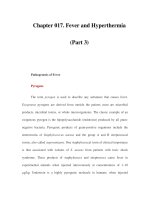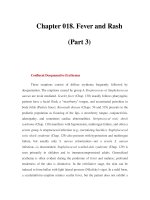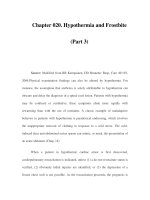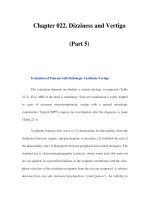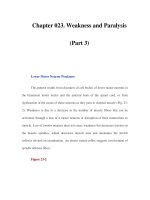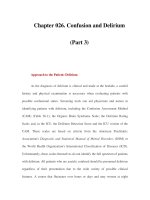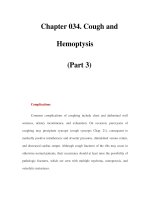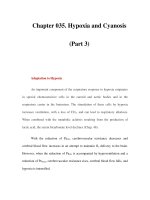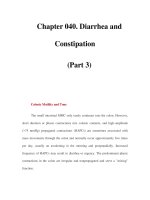Chapter 053. Eczema and Dermatitis (Part 3) pptx
Bạn đang xem bản rút gọn của tài liệu. Xem và tải ngay bản đầy đủ của tài liệu tại đây (83.14 KB, 5 trang )
Chapter 053. Eczema and
Dermatitis
(Part 3)
Lichen Simplex Chronicus
Lichen simplex chronicus may represent the end stage of a variety of
pruritic and eczematous disorders, including atopic dermatitis. It consists of a
circumscribed plaque or plaques of lichenified skin (thickening of the skin and
accentuation of normal skin markings) due to chronic scratching or rubbing.
Common areas involved include the posterior nuchal region, dorsum of the feet,
and ankles. Treatment of lichen simplex chronicus centers on breaking the cycle of
chronic itching and scratching. High-potency topical glucocorticoids are helpful in
most cases, but in recalcitrant cases, application of topical glucocorticoids under
occlusion, or intralesional injection of glucocorticoids may be required. Oral
antihistamines such as hydroxyzine (10–25 mg every 6 h) or tricyclic
antidepressants with antihistaminic activity, such as doxepin (10–25 mg at
bedtime), are useful primarily due to their sedating action. Higher doses of these
agents may be required, but sedation can become bothersome. Patients need to be
counseled regarding driving or operating heavy equipment after taking these
medications.
Contact Dermatitis
Contact dermatitis is an inflammatory process in skin caused by an
exogenous agent or agents that directly or indirectly injure the skin. This injury
may be caused by an inherent characteristic of a compound—irritant contact
dermatitis (ICD). An example of ICD would be dermatitis induced by a
concentrated acid or base. Agents that cause allergic contact dermatitis (ACD)
induce an antigen-specific immune response (poison ivy dermatitis). The clinical
lesions of contact dermatitis may be acute (wet and edematous) or chronic (dry,
thickened, and scaly), depending on the persistence of the insult (see Fig. 52-10).
Irritant Contact Dermatitis
ICD is generally well demarcated and often localized to areas of thin skin
(eyelids, intertriginous areas) or to areas where the irritant was occluded. Lesions
may range from minimal skin erythema to areas of marked edema, vesicles, and
ulcers. Chronic low-grade irritant dermatitis is the most common type of ICD, and
the most common area of involvement is the hands (see below). The most
common irritants encountered are chronic wet work, soaps, and detergents.
Treatment should be directed to avoidance of irritants and use of protective gloves
or clothing.
Allergic Contact Dermatitis
ACD is a manifestation of delayed-type hypersensitivity mediated by
memory T lymphocytes in the skin. The most common cause of ACD is exposure
to plants, especially to members of the family Anacardiaceae, including the genus
Toxicodendron. Poison ivy, poison oak, and poison sumac are members of this
genus and cause an allergic reaction marked by erythema, vesiculation, and severe
pruritus. The eruption is often linear or angular, corresponding to areas where
plants have touched the skin. The sensitizing antigen common to these plants is
urushiol, an oleoresin containing the active ingredient pentadecylcatechol. The
oleoresin may adhere to skin, clothing, tools, and pets, and contaminated articles
may cause dermatitis even after prolonged storage. Blister fluid does not contain
urushiol and is not capable of inducing skin eruption in exposed subjects.
Contact Dermatitis: Treatment
If contact dermatitis is suspected and an offending agent is identified and
removed, the eruption will resolve. Usually, treatment with high-potency topical
glucocorticoids is enough to relieve symptoms while the dermatitis runs its course.
For those patients who require systemic therapy, daily oral prednisone beginning
at 1 mg/kg, but usually ≤60 mg/d, is sufficient. It should be tapered over 2–3
weeks, and each daily dose given in the morning with food.
Identification of a contact allergen can be a difficult and time-consuming
task. Patients with dermatitis unresponsive to conventional therapy or with an
unusual and patterned distribution should be suspected of having ACD. They
should be questioned carefully regarding occupational exposures and topical
medications. Common sensitizers include preservatives in topical preparations,
nickel sulfate, potassium dichromate, thimerosal, neomycin sulfate, fragrances,
formaldehyde, and rubber-curing agents. Patch testing is helpful in identifying
these agents but should not be attempted on patients with widespread active
dermatitis or on those taking systemic glucocorticoids.
Hand Eczema
Hand eczema is a very common, chronic skin disorder in which both
exogenous and endogenous factors play important roles. It may be associated with
other cutaneous disorders such as atopic dermatitis, and contact with various
agents may be involved. It represents a large proportion of occupation-associated
skin disease. Chronic, excessive exposure to water and detergents, harsh
chemicals, or allergens may initiate or aggravate this disorder. It may present with
dryness and cracking of the skin of the hands as well as with variable amounts of
erythema and edema. Often, the dermatitis will begin under rings where water and
irritants are trapped. Dyshidrotic eczema, a variant of hand eczema, presents with
multiple, intensely pruritic, small papules and vesicles occurring on the thenar and
hypothenar eminences and the sides of the fingers (Fig. 53-2). Lesions tend to
occur in crops that slowly form crusts and heal.
